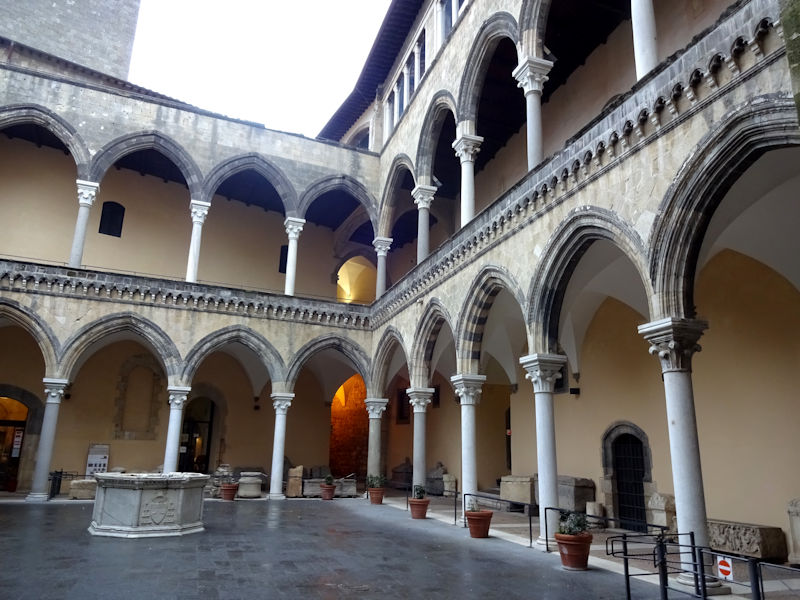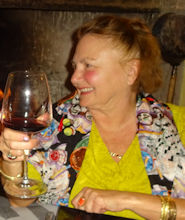You may not find this terribly rewarding unless you're included here, so this is a good time for casual and random browsers to turn back before they get too caught up in the sweep and majesty of the proceedings and can't let go.
The plan is to luxuriate for twelve days in Viterbo, with enthusiastic sight-seeing in the region, and a few days tacked onto either side of that for getting there and back.
An afternoon in Tarquinia

4 December 2017, we've spent the morning visiting the Castello di Santa Severa on the Tyrrhenian coast, and now . . .

. . . we're passing through the gates of Tarquinia 30km to the north.

The back and belltower of the Church and Convent of San Francesco. The modern town of Tarquinia, 50km north of Rome and 6km from the Tyrrhenian shore in the province of Viterbo, lies near the ancient Etruscan town of Tarchna or Tarchuna (Tarquinii to the Romans) and adjacent to the Etruscan necropolis that is now a UNESCO World Heritage Site, featuring 6,000 rock-cut tombs of which 200 contain wall paintings from the 7th century BC onward.

The Chiesa e Convento di San Francesco at the top of the old town, built around the early 14th century and thoroughly renovated in the early 16th.

A narrow Gothic nave with two aisles, and five chapels along the right side.

They're busy up front; we won't disturb.

The ancient site of Tarquinia was occupied from at least the Bronze Age, but the city developed rapidly with the Etruscans' increased contact with Greek colonies by the 8th century, taking advantage of its seaport called Gravisca and its proximity to the partially navigable Marta river from the Lago di Bolsena -- it's considered to have been, by the early 5th century, the most important of the 12 cities of the Etruscan League. The Tarquinian dynasty of Roman kings, overthrown in 509 BC, is assumed to have originated here.

The Piazza Giacomo Matteoti, with the city hall on the left. Tarquinii and Rome began military scuffling in the 4th century BC, and sometime in the 3rd century the Romans came to dominate the city; in 181 BC the Romans established a maritime colony in Gravisca and then a municipium in Tarquinii, but the city didn't regain the importance it had enjoyed under the Etruscans and faded into the Roman imperial background.

The Palazzo Comunale, dating from the 13th century, originally comprising the Palazzo del Podesta (for the chief administrative officer and staff) and the adjacent Palazzo dei Priori (or council hall for the city grandees), built as part of the southeastern city wall running down this road.

The Piazza Matteoti. In late- and post-Roman times, Tarquinia itself continued to languish, as the nearby settlement of Corneto began to take its place; both sites were mentioned in the 4th century AD, but Corneto itself is first mentioned as growing up around the castle of the 6th or 7th century and persisting long after Tarquinia itself seems to have been razed by the Saracen pirates in the 9th century. The city of Corneto was renamed 'Tarquinia' by Mussolini in 1922.

Corneto had been incorporated as part of the Papal Patrimony as early as AD 787, but was gaining importance by the 11th century and by the 12th century was involved in trade agreements with Genoa, Pisa, and Venice, largely because of lucrative trade up the Marta river.

The civic fountain from 1724. The Vitelleschi family rose to prominence in the city in the 14th century, and by resisting the papal authority of the Avignon popes drew the attention of the Cardinal Albornoz, the papal enforcer . . . so Corneto was besieged and looted in 1355.

The bottom half of the Chiesa di San Pancrazio, right behind the Palazzo Comunale. Giovanni Maria Vitelleschi of Corneto was a well-known bishop and cardinal and extraordinarily vicious military commander who in the 1430s helped Pope Eugene IV defeat his Colonna tormenters, retake Rome in a bloody manner, and put down rebels in the region in the name of papal authority. One of his rewards was to have Corneto elevated to the seat of a new bishopric in 1435.

The Church of San Pancrazio is considered on stylistic grounds to have been built in about 1200; it functioned religiously until the early 1900s and was later renovated and turned into a venue for concerts, exhibitions, and conferences.

Towers in the city: there were at its peak some 40 tower houses in Corneto, of which 18 survive, more than in famous San Gemignano.

Mistakenly called the 'Palazzo dei Priori', this agglomeration of four 12th century towers now houses the Ceramics Museum.

The 12th-13th century Torre Draghi (Tower of Dragons)

The Torre Barucci, on the Via delle Torri, coming up

Tarquinia street scenes

Kristin at the 11th century Torre Barucci

The belltower of the Duomo on the horizon

A profferlo of the Viterbo region, external staircase onto a balcony covering a shop or workshop underneath

The Archivo Storico -- the city's historical archives are housed in the Palazzetto of S. Spirito, a 15th century former hospital.

Cathedral belltower

The Tarquinia Cathedral, or Cattedrale dei Santi Margherita e Martino, was made a cathedral in 1436 and then expanded by Bishop Bartolomeo Vitelleschi, but was destroyed by fire in 1643 and reconstructed by the end of the 19th century; it was formerly the episcopal seat of the Diocese of Corneto, but since 1986 it has been a co-cathedral of the Diocese of Civitavecchia-Tarquinia. It's said to have frescoes by Antonio del Massaro ('Il Pastura') of Viterbo in there, but we were put off by the façade.

The Piazza Cavour on the central Corso Vittore Emanuele . . .

. . . and the same, looking seaward.

Also on the Piazza Cavour, this is the Palazzo Vitelleschi, home of the Museo Nazionale Tarquiniense, one of the foremost museums of Etruscan civilization.

The palace was commissioned by Cardinal Giovanni Vitelleschi between 1436 and 1439, incorporating existing buildings from the 12th to 14th centuries. It's said to have self-consciously been designed in the manner of a Florentine Renaissance palazzo.

The courtyard is surrounded by three stories (for services, guests and public events, and family privacy in ascending order) with loggias and columns around three sides and a fortified wall along the fourth, and with a central well drawing from an underground reservoir.

The inevitable Etruscan sarcophagi. The palace served for some years as a resort and refuge of popes and was then taken over by the prominent Soderini family of Florence; in 1900 it came into the city's hands, and then to the government for the archaeological museum which opened in 1924.


Four the earliest Etruscan sarcophagi found near Tarquinia, from the late 4th century BC

Just past the Cappella Palatina on the top floor, this is the Studiolo of Cardinal Vitelleschi, with a cycle of frescoes illustrating the story of . . .

. . . the 'Rape of Lucrece", or Lucrezia, who was said (by Livy, mainly) to have been raped by Sextus Tarquinius, son of the Lucius Tarquinus Superbus, the last king of Rome, which is largely why in 509 BC he became the last king of Rome.

The top-floor hall overlooking the front of the palace

Cardinal Vitelleschi, by the way, having begun the building of this palace, was made governor of Rome by Pope Eugene IV, who then lost faith in his Cardinal and had him murdered by the commander of the Castel Sant'Angelo in 1440. So it goes.


A look up the street, the Via Giuseppe Mazzini, with the palace's tower and, in the distance, the Tower of Matilda of Canossa, the 11th century phenomenon known as the 'Gran Contessa'.


Loggia views

The amazing terra cotta frieze of the Winged Horses of Tarquinia, probably from the 4th century BC and discovered in 1938 in the Etruscan temple called the Ara della Regina, or Queen's Temple, just up the Via San Pancrazio, originally hitched to a chariot that is no longer with us.

Roomfuls of pottery


Including a whole X-rated section



Vitelleschi Views

On the battlements

The Piazza Cavour below us and . . .

. . . the Tyrrhenian Sea on the horizon

Juan Carlos cooling his heels

We've been spotted.

And so has Juan Carlos

We're gathering near the exit.

An ancient well and an unclothed dancer or gymnast

In 1537, Pope Paul III gave Corneto to his illegitimate son, the mercenary soldier Pier Luigi Farnese, in making him the first Duke of Castro, including the land between the Tyrrhenian Sea and the Lake of Bolsena and centred on the town of Castro on the lake. This separated the city from the resources of its contado or local countryside and contributed to its decline. The duchy was forcibly absorbed back into direct papal control in 1649.

A mutual obsession with cats however unresponsive they may be

Street artists aiming at the traditional market

Yum

Leaving Tarquinia by the city gates in the rain
Back in Viterbo, our last night in town

A stunned mom perhaps abandoning her kid on the Santa Claus line

And a very long line it is. (And hundreds of those parents and grandparents probably don't even believe in Santa Claus.)

A carpark for baby strollers

The entertainment has arrived.

Kids' photos with the bagpiper and flautist

Our last dinner at Lo Scarfano


Playing the jackanapes

A last toast. Tomorrow Juan Carlos is off home to Palma de Mallorca and we're headed north to Sarzana.

Settling up and having laughs with the owner (who [I think] is a dead-ringer for the celebrity chef Giorgio Locatelli)

Back out into the street

The kids are gone, and Santa Claus has gone to bed.
Tomorrow: Sarzana and points north

























































































